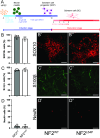Interactions among Merlin, Arkadia, and SKOR2 mediate NF2-associated human Schwann cell proliferation
- PMID: 40188079
- PMCID: PMC11972516
- DOI: 10.1186/s13287-025-04281-x
Interactions among Merlin, Arkadia, and SKOR2 mediate NF2-associated human Schwann cell proliferation
Abstract
Background: NF2-related Schwannomatosis (previously referred to as Neurofibromatosis Type 2, or NF2) is a genetic-associated disease resulting from mutations in the gene, NF2. NF2 encodes the Merlin protein, which acts as a tumor suppressor. Bilateral vestibular schwannoma (VS) is a hallmark of NF2. Although the exactly molecular mechanism mediating NF2-driven schwannomatosis is not fully understood, it is known that defective Merlin protein functionality leads to abnormal cell proliferation.
Methods: Herein, we utilized a human induced pluripotent stem cell (hiPSC)-based Schwann cell (SC) model to investigate the role of Merlin in human SCs. SCs were derived from hiPSCs carrying a NF2 mutation (c.191 T > C; p. L64P), its isogenic wild-type control cell line, and a NF2 patient-derived hiPSC line. Phenotypes were determined via immunocytochemistry and various bioassays. Different proteins interacting with Merlin in wild-type and NF2 mutation SCs were identified using co-immunoprecipitation followed by mass spectrometry.
Results: SC derived from NF2L64P hiPSCs showed significantly higher proliferation and abnormal morphology compared to NF2WT SCs. Phenotypes that could be restored by wildtype NF2 overexpression. Interactome profiling of Merlin (NF2) in SCs derived from NF2WT- and NF2L64P- hiPCSs identified differential protein binding levels. Among identified proteins, we validated the interaction among Merlin, an E3 ubiquitin ligase (Arkadia), and a SKI family co-repressor (SKOR2). This complex plays a significant role for this interaction in SC proliferation. Our findings were further validated by SCs derived from the patient-derived hiPSCs carrying a deletion in the chromosome 22 which spans the NF2 gene.
Conclusions: Our results presented a hiPSC-derived SC system for SC-related disease modeling and established a new model in which Merlin interacts with Arkadia and SKOR2. This interaction is required for the proper cell proliferation in human SCs.
Keywords: Human induced pluripotent stem cells; Merlin; NF2; Proteomic analysis; Schwann cells; Schwannoma.
© 2025. The Author(s).
Conflict of interest statement
Declarations. Ethics approval and consent to participate: For patient sample collection: Title of the approved project: Vestibular Schwannoma. Name of the institutional approval committee: University of Miami IRB committee. Approval number: 20150637 Date of approval: 9/26/2017. We confirmed that the patient and their guardian provided written informed consent for participation in the study and/or the use of samples. For hiPSCs usage: Title of the approved project: Molecular Basis of NonSyndromic Deafness. Name of the institutional approval committee: University of Miami IRB committee. Approval number: 20010415 Date of approval: 11/5/2007. The original source has confirmed that there was initial ethical approval for collection of human cells, and that the donors had signed informed consent. Consent for publication: All authors confirm their consent for publication. Competing interest: The authors declare no competing interests.
Figures







Update of
-
Interactions among Merlin, Arkadia, and SKOR2 mediate NF2-associated Schwann cell proliferation in human.bioRxiv [Preprint]. 2024 Sep 26:2024.09.24.614711. doi: 10.1101/2024.09.24.614711. bioRxiv. 2024. Update in: Stem Cell Res Ther. 2025 Apr 05;16(1):163. doi: 10.1186/s13287-025-04281-x. PMID: 39386608 Free PMC article. Updated. Preprint.
References
-
- Jessen KRMR. The origin and development of glial cells in peripheral nerves. Nat Rev Neurosci. 2005;6(9):671–82. - PubMed
-
- Kennedy WP, Brody RM, LiVolsi VA, Wang AR, Mirza NA. Trauma-induced Schwannoma of the recurrent laryngeal nerve after thyroidectomy. Laryngoscope. 2016;126(6):1408–10. - PubMed
-
- Goetsch Weisman A, Weiss McQuaid S, Radtke HB, Stoll J, Brown B, Gomes A. Neurofibromatosis- and schwannomatosis-associated tumors: approaches to genetic testing and counseling considerations. Am J Med Genet Part A. 2023;191(10):2467–81. - PubMed
-
- Kluwe L, Mautner V-F. Mosaicism in sporadic neurofibromatosis 2 patients. Hum Mol Genet. 1998;7(13):2051–5. - PubMed
-
- DG. E. NF2-Related Schwannomatosis.: Seattle (WA): University of Washington, Seattle. 1998 [updated 2023. Available from: https://www.ncbi.nlm.nih.gov/books/NBK1201/
MeSH terms
Substances
Supplementary concepts
Grants and funding
LinkOut - more resources
Full Text Sources
Research Materials
Miscellaneous

